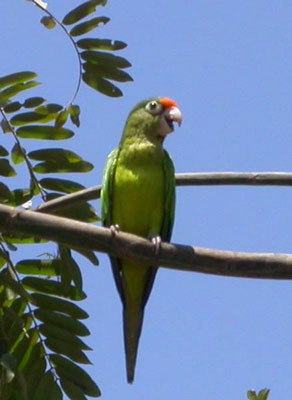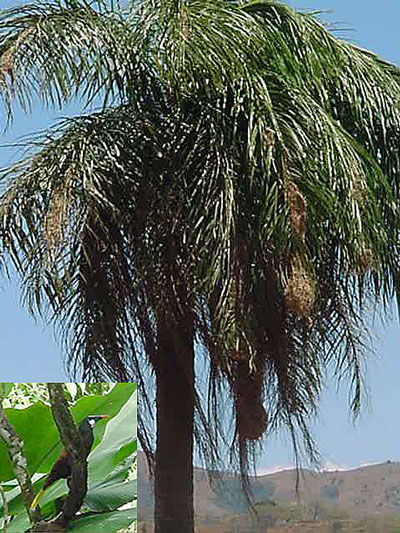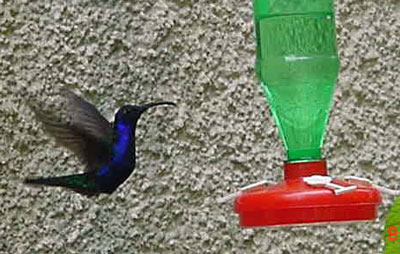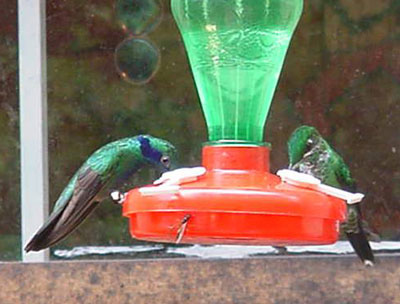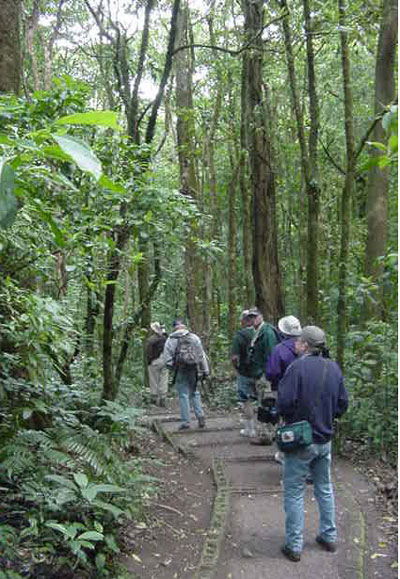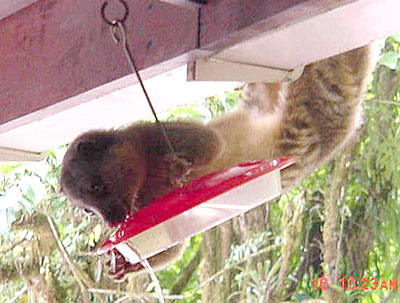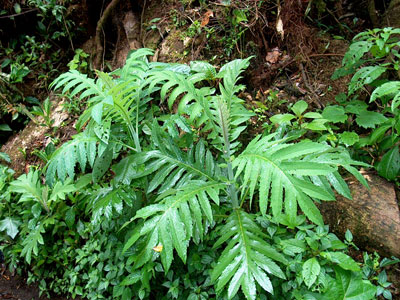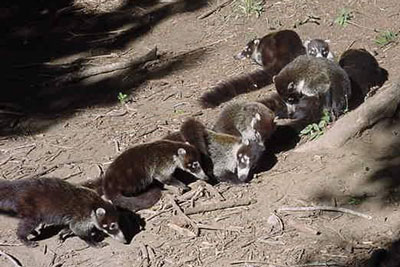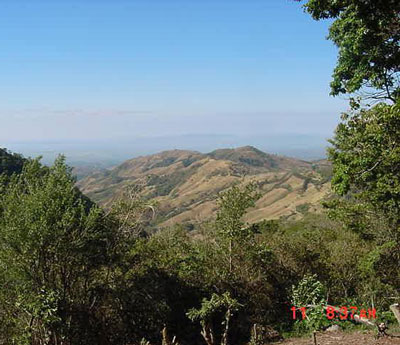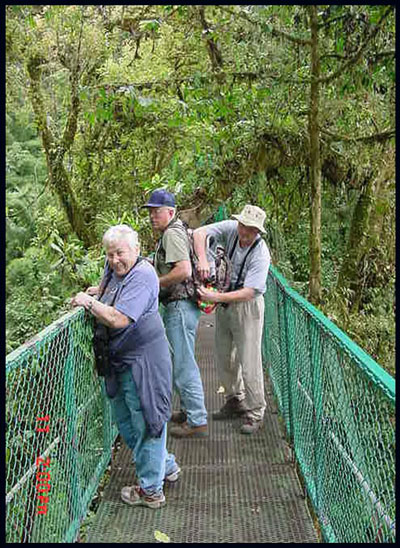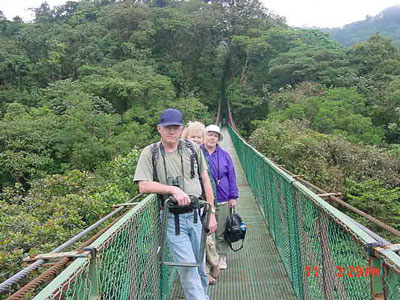|
Costa Rican Birding Adventure by Ned C. Hill Part 2—The Monteverde Cloud Forest |
|||
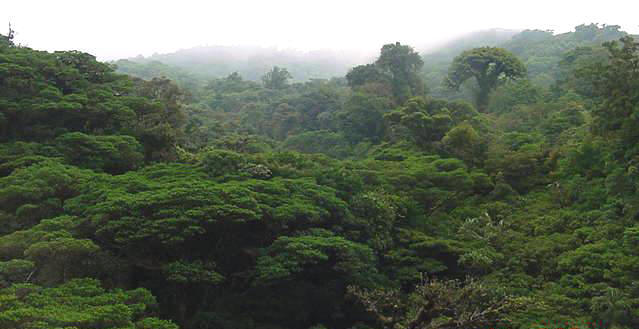 |
|||
| The Cloud Forest by Ned Hill | |||
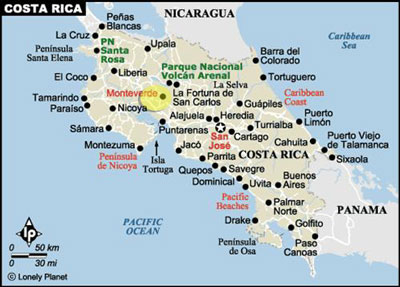 |
Jacó to Monteverde Day three of our adventure again began at 5:30 am when we looked for birds from the motel balcony and enjoyed breakfast. Three Bare-throated Tiger-Herons strutted on the roof of the neighboring building puffing out their yellow throat patches and making guttural sounds. It was a rather comical sight. We identified a White-fronted Parrot in a distant tree and saw three noisy Mealy Parrots fly over. Dennis spotted for us a Thick-billed Euphonia perched in the top of a tree. Determined to get a good look at the Rufous-tailed Hummingbird, I sat by the pool until one perched on a branch for me to study it. As this was Sunday, we held a brief Church service in Dennis’s room and then loaded up the van. On the way out of town on this bright, sunny morning, Tuula spotted a Roadside Hawk perched on a pole—where else—on the roadside. We did a quick U-turn and went back to study it. At the Tarcoles River Bridge, we found a very aggressive Cinnamon Hummingbird defending its flower patch. It is a close relative of the Rufous-tailed so we had to study it carefully. This is the northern-most extent of its range. No Barred Antshrike that Tom and Carol Jean had seen at this spot before we arrived. We stopped for gas outside Puntarenas where I met a German man who moved here 20 years ago. He told me in German that there were many of his countrymen in that area. He is a rock mason. He also told me that many Mormons had settled Monteverde where we are headed. "They make great cheese up there." We think he was talking about the Quakers. We finally left the Pan American Highway and started up the famous—or infamous—40 km long dirt and rock road towards Monteverde. It’s pretty rough and demands very tough tires. We were amazed that this most famous of all Costa Rican natural attractions does not merit a paved road. Perhaps the road is a barrier to overuse. We later saw T-shirts boasting, "I survived the road to Monteverde." We stopped several times to check the birds, once finding an Orange-fronted Parakeet when we stopped to see the Groove-billed Anis. We also saw a Montezuma Oropendula fly over and then saw this species’ huge nests hanging from a palm tree. They are like large tubes. The terrain is very dry and mountainous here but in the distance we could see dense clouds blanketing the top of the cloud forest. After seemingly endless bumps and lurches we finally reached the spread out towns of Monteverde-Santa Elena. A soccer game was being played in a park next to a school and the whole town was there to watch. Fans sat on the steps of businesses to cheer on their team. We finally reached a paved road—but like a mirage, it disappeared as soon as we found it and we went back to bumping and lurching. At last our motel appeared: the Miramontes Swiss Hotel with its lovely grounds of grass, flowers and orchids. The air was cool, a welcome change from the steamy humidity of the coastal area. Walter Faisthuber, the proprietor, greeted us and led us to our spartan rooms. Some rooms did not have hot water but others did. There were no TVs nor phones to distract us. We immediately found a Yellow-faced Grassquit and Rufous-collared Sparrow in the lawn and saw some hummingbirds we couldn’t initially identify at the flowers. We could hear the ringing call of the Three-wattled Bellbird but we could not locate it.
|
||
|
|||
|
|||
|
Hummingbird Gallery After a brief break to unpack and enjoy a quick lunch on Dennis’s porch, we loaded into the van for the bumpy drive up to the entrance of the Monteverde Cloud Forest Preserve. We did not go in this afternoon because our target was a gift shop called for good reason the "Hummingbird Gallery." Within a few seconds, we saw 8 lifers! They have a dozen or so hummingbird feeders around the outside of the shop and these are visited by zooming, bickering hummingbirds—at least seven different species plus Bananaquit, a small warbler-like bird with a yellow belly. There were large Violet Saberwings—beautiful purple hummingbirds with downcurved bills and white undertails. We also saw Purple-throated Mountain Gem, Green Violetear, Green-crowned Brilliant, Coppery-headed Hummingbird, Stripe-tailed Hummingbird, and the tiny Magenta-throated Woodstar that hovers with its tail up when it feeds. We could approach them to within a couple of feet and get great photos. They zoomed by so closely we could sometimes feel their wings brush our heads. Some of our group went into the gift shop to buy T-shirts and postcards. LeIla is our chief shopper. Besides hummingbirds, we found a Common Bush-Tanager, a dull, khaki-colored bird that became THE bird for Carol Jean for some unknown reason. From then on, we were careful to point out that bird whenever we saw it. In a branch above the road we found a singing White-throated Robin. We drove down a mile or so and stopped at a turn out where Carol Jean spotted high in the trees a couple of Golden-browed Chlorophonias one of the most striking of the tanagers: green back, yellow breast and brow, black band and blue nape. One of our favorite birds of the trip. How did Carol Jean see them way up there? Further down the road, next to a farm field owned by some Quakers, we found a pair of Keel-billed Toucans and an Emerald Toucanet—another very colorful green bird. Back at the Swiss Hotel, we ate dinner in the small dining room where Walter
entertained us with some classical guitar pieces. Then he and Kathi sang
together (one number was the Simon and Garfunkle "The Boxer") while he
accompanied on the guitar. Not bad at all! The only problem was that some of the
guests at dinner decided to smoke—typical European custom. I found an
interesting centipede in my shower and Dennis was disappointed I didn’t collect
it for him! |
|||
|
|||
|
|
|||
|
Monteverde Cloud Forest Preserve
The wind blew strongly all night and it became quite cool. Some of us were up very early to look for the Bellbird just off the property. We could hear its metallic, echoing "PRONNNG" clearly and approached the sound but it always was further off than we calibrated. We did see Keel-billed Toucan. Breakfast was excellent: fruit, beans and rice, and scrambled eggs plus hot chocolate and bread. Then off to Monteverde Cloud Forest Preserve. They admit only a limited number of people into the preserve at any one time so we had to be sure to get there early or we would have missed out for the morning. It was cool enough for a jacket and one never knows when it might rain in a cloud forest. When we arrived there were bus loads of students but we were able to get in. We chose a trail not popular with the crowds. It was dark, moist and absolutely beautiful. Large trees were completely covered with epiphytes of all varieties. The trail consisted of cinderblocks laid so we walked on the open spaces filled with dirt. The footing would have been treacherous in the rain without the precautions they took. Very quiet. We soon heard the ringing, thrush-like sound of the Black-faced Solitaire and finally saw one relatively close to us. A loquacious singer, the Gray-breasted Wood-wren, was coaxed into view. Then Tom found a small bird but it flitted away. Bryan decided to give in and use the Costa Rican bird CD. He played the sound of the White-throated Spadebill and immediately, Tom’s little bird flew near enough for all to see it. We tried that technique with Slate-throated Redstart and immediately had several surrounding us. We had been hearing their calls and knew they were nearby but just couldn’t see them. That’s the problem with forest species. We heard an Orange-bellied Trogon in the distance and tried calling it in. It worked again and we got great looks at that beautiful species. We hope we are not upsetting their nesting behavior. We only used the CD sparingly and never for very long. A Green Hermit (a hummingbird with a long tail and downcurved beak) hovered near us and several Three Striped Warblers sang for us. Nearing the end of the looped trail, we found a great little woodcreeper, a Spotted Barbtail, and saw another Slate-throated Redstart on the trail where we could see its little rufous cap. Back at the gate area, we took a break to have a snack and rest for a bit. They have a couple of hummingbird feeders around a picnic area. Nothing new except a Kinkajou that came down from the roof and wrangled its way to a nice drink of hummingbird nectar. We talked to some people from Oregon who told us where to look for Quetzals. Most people on the trails speak English—even many of the school kids are Americans. We set out again into the cloud forest, this time on the Camino Trail. We found a Yellowish Flycatcher, a Ruddy Treerunner and a Red-faced Spinetail. We walked up and down steep trails trying to locate the Quetzal area and finally located it. It was marked by a tall stump with evidence of a fresh hole being dug by the female Quetzal. We searched high and low until Bryan spotted the female Resplendent Quetzal very high in a huge tree. It was not green like pictured in the field guides but turquoise blue with a red belly—at least in that light. I thought it was a macaw at first. Dennis soon located the male—also blue! Their feathers are iridescent and depend on reflected light for their color. The male’s huge tail was amazing. A Spanish-speaking couple came by and we pointed the Quetzals out to them. They seemed thrilled to be able to get a good look through the scope. We returned to the picnic area where they had a small concession stand. We bought lunch: chicken, rice and vegetables. Most of us avoided the lettuce and tomatoes but we heard that up here they are not dangerous. Then we left for lower right-hand trail where, in the late afternoon sun, the forest was fairly quiet. We saw another Orange-bellied Trogon and got great looks at Emerald Toucanet that some of us missed yesterday. We heard some very strange sounds coming from a thick patch of ferns and discovered they were made by Gray-breasted Wood Wrens. On the way back to our hotel, Dennis and Bryan took us to their favorite restaurant, Johnny’s Pizza. It was excellent. Our legs ached from the four to five miles of hiking we had done up and down steep trails. We all slept well while the wind picked up and the temperature dropped. I called home and found that the BYU basketball team had won its last two games and thus shared the conference championship with Utah. We were up in the brisk wind at 5:15 to search for the Bellbird. We immediately heard it’s penetrating "PRANG" in the distance and headed out in that direction. We plunged through heavy grasses and trudged over hilly pastures hoping that chiggers would not invade our socks and shoes. Three Chestnut-headed Oropendula flew over us. The Bellbird was very close but high in a group of trees. It would give several equally spaced, clear whistles and then "Prang!" We surrounded the suspect tree but it was protected by smaller trees and undergrowth. Dennis glimpsed it fly from one perch to another and then it flew out and bounded away towards another tree. We only caught sight of a mid-sized brown bird with a light head. So close but not a very good look. We could hear it "Pranging" again in the distance. We did find a White-crowned Parrot and a Gray-crowned Yellowthroat. |
|||
|
|
|||
|
|
|||
|
|||
|
Ecological Farm After another hearty breakfast at the hotel we headed to a slightly lower altitude below the Monteverde Cloud Forest. The place is called the Ecological Farm—it’s an old farm that is now a great birding spot with open secondary woods and remnants of a banana plantation. It has a completely different set of birds than can be found in the cloud forest. We found a family of White-nosed Coati gathered on the edge of the parking lot. They look like they are related to our racoons. The first new bird we spotted was turning leaves in the undergrowth—a cute little White-eared Ground Sparrow. A familiar Ovenbird walked in front of us on the trail. Then we went to an overlook affording us a view all the way down to the Pacific Ocean. Bryan used a tape to call in a Rufous-browed Pepper Shrike and a Plain Wren. A short distance from the overlook was a known lek of a Long-tailed Manakin, one of the most desired targets of the trip. We could hear the call notes and the wing popping similar to the Orange-collared Manakins we found in Carara. We all fanned out along the trail to watch for the bird. Soon Dennis had the bird in view. All rushed up to get a look. It disappeared before I could see it well. Then a male flew in again to a tree branch just above our heads in full sun and all of us got a great look at the long tail streamers, blue back and red head. What a beautiful bird! At the edge of an old banana grove some of us found a Chiriqui Quail-Dove
walking along hunting for insects. It disappeared into the thick undergrowth
before all of us got the chance. As we sat on our folding stools in front of a
large bush of flowers, a number of hummingbirds came in. One fairly large one
had a down-curved bill: a Green Hermit. Another was a female
Fork-tailed Emerald. When some of the group plunged into the underbrush to
look for the Quail-Dove, they found instead several Gray-headed Chachalacas.
All of us followed them to see these new birds. In the distance, another
Bellbird teased us without showing itself. However, a female Three-wattled
Bellbird flew into a tree in an old orchard. It looks like a different
species from the male—green with a lighter, streaked breast. A Golden Olive
Woodpecker also flew into one of the orchard trees. We identified a
Steely-vented Hummingbird with light gray "leggings" around its feet. |
|||
|
|
|||
|
|||
|
Selvatura Skywalk One of the problems in birding in thickly forested area is finding and identifying birds that prefer the canopy. To give birders better odds and to provide a unique view of the forest, people have started building "skywalks" through and above the trees. The newest of these in Monteverde is Selvatura. We arrive there after a tasty lunch in town. The first thing to do at Selvatura is to visit their new hummingbird gallery. Green Hermits came in several times but the other hummers were the same species we had seen in Monteverde. As we watched hummingbirds an American Swallow-tailed Kite flew over our heads displaying its graceful forked tail. The day was cloudy and cool—rain threatened. The trail goes over eight bridges that take visitors above or into the canopy. The huge trees are covered with epiphytes. From the first bridge, we found Ochraceous Wren working a trunk and a Red-faced Spinetail in the branches. I had missed that one the other day. From the trail we came upon a "kettle" of birds and people began calling out "Collared Redstart, Three-striped Warbler, Golden-winged Warbler, Barred Becard…" They flitted here and there so quickly, I missed most of them. High in the trees near one of the longer bridges, we heard the strange sounds of the Prong-billed Barbet—almost like the Laughing Kookaburra in Australia. With some effort, we found several of them in the canopy and could not call them down any closer. As we searched for the barbets, Carol Jean spotted a Brown-headed Parrot also very high up. The view from this long bridge was spectacular with the forest canopy stretching out below our feet and clouds swirling over the horizon. At the far end of the bridge in the shrubbery, we found a black bird with strikingly yellow "leggings," the Yellow-thighed Finch. The strong breeze and late afternoon combined to keep many birds out of the canopy. Back at the parking lot—now almost socked in with mist—we found Blue-and-white Swallows perched on a wire and before we got into the van, a Black Guan sailed right over our heads. When we returned to the Swiss Hotel, Walter told us that a male Bellbird had sat for over an hour in a tree right across the street! Such is birding. We ate at the hotel and then some of us went owling. It was fruitless because of the wind and the feeble power of our CD player and tape recorder. We soon gave up and went to bed. Before we left this heavenly area the next morning, we birded a little down the road from the hotel—again hearing but failing to find the male Bellbird. Again we got a look at the female. And we added Eastern Meadowlark and Western Wood Peewee to our list. Before we boarded our van, Walter showed us some of his 4,500 specimen butterfly collection. It’s amazing to see the variety of colors, sizes (from ½" to large 7-8"bird butterflies from SE Asia) and shapes of butterflies in his collections. Many Morpho butterflies are bright blue on the upper surface but leaf-colored on the underwing. Some specimens he obtained by trade from other collectors. He collects local species just outside the hotel. He left a much larger collection of 20,000 or more in Switzerland. Some of his specimens are worth $3,000 to $5,000. Reluctantly we bade farewell to this memorable part of Costa Rica and started down the bumpy road towards new adventures in the direction of Lake Arenal. |
|||
|
|||
|
|||
|
|
|||
|
Copyright 2003 © Ned C. Hill – All
Rights Reserved |
|||
